History & heritage
Recent history and the campaign
From around 2011 the site became a focus of interest for several local groups, with an amateur archeological dig to unearth the industrial history of the site back to its roots in Victorian times by The Friends of Norwich City Station (FONCS), who were on site and held open days to view the findings for over a year. The site also became a focus of activity for Norwich Green Gym, who made a serious attempt to maintain the area, including lopping, clearing, and opening up a pond that was becoming weeded up.
Norwich City Council had assumed responsibility for the land, believing that they owned it. However, after some confusion, it was found to belong to Norfolk County Council. Soil tests were carried out and some contamination from its railway days was found on site and work was then undertaken by the County Council to clean up the area. Unfortunately, the local wildlife and train heritage groups were prevented by the Council from doing the voluntary management they had been enthusiastically undertaking.
Then matters took a turn for the worse. Cabinet member for resources, Cllr Cliff Jordan, agreed to the land being put up for sale at auction as it was ‘surplus to requirements’. A petition was raised objecting to the sale of the public land. This achieved nearly 2,000 signatures within a matter of weeks, and was handed in at both City Hall and County Hall in April 2013. Friends of Train Wood and Marriott’s Way was formed to campaign to ensure that the wood stayed in public hands. The wood was abruptly withdrawn from sale just days before the auction was due to take place.
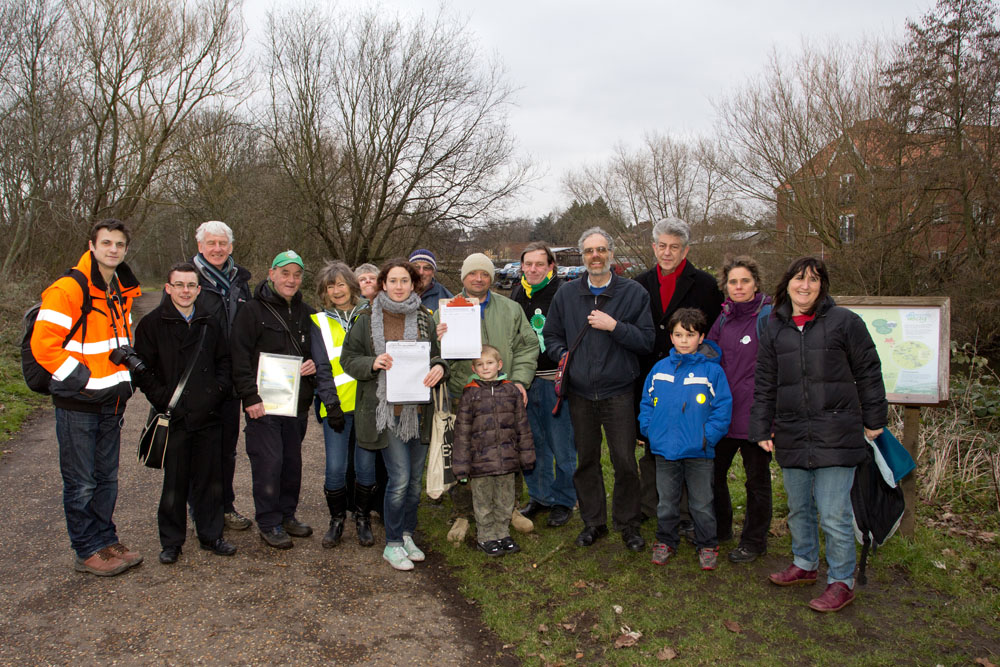
Friends of Train Wood and Marriott’s Way then went on to campaign through local elected members, legal representations and many meetings to ensure that the site was kept in public hands, as although it had been withdrawn from the auction it remained on the disposal list. The group listed the site as an Asset of Community Value (ACV): the first green space to be listed as such in the city and only the second ACV at that point. Several meetings with Norwich City Council to ask them to take it on, as it is a key city wildlife and amenity site, proved fruitless.
Legal representation was retained, with Mills and Reeve Solicitors acting for free for the group, to examine the possibility of taking on a long lease of the site. However eventually, following a meeting, Norfolk County Council member David Harrison agreed to take it off the disposal list.
Saving Train Wood: campaign timeline
March 2013 County council announces sale of Train Wood at auction with a guide price of £26,000
April 2013 Petition to Norwich City and Norfolk County councils to work together to keep Train Wood in public hands gets nearly 2,000 signatures
April/May 2013 Ruling Tory administration of Norfolk County council announces it will hold off sale to allow groups to bid; later confirmed by new Labour administration
August 2013 Friends of Train Wood officially forms and gets the site formally listed as an Asset of Community Value
March 2014 Friends of Train Wood now numbers 50 members; wins Norwich city council eco award for its activities including litter picks, surveys and events
September 2014 Deputy Leader Norfolk County Council David Harrison agrees Friends of Train Wood develops management plan for site with Land Trust; presents to Norfolk county council
November 2014 Train Wood removed from for sale portfolio; Norfolk County Council agree to undertake the site management, look to a range of funding sources
Deeper history of the site
The site of Train Wood is as important as the woodland itself. Originally marshland on the floodplain of the River Wensum, it forms an important part of the Wensum Valley, that is crucially still in its green state. The site has seen various uses over the last few hundred years and has been settled for several thousand, with evidence of prehistoric settlement between the Wensum and the River Tud. Norwich was originally formed from several settlements, Coslayne being one of the original ones on the site.
This area sits where modern day Coslany is to the south of the Woodland. There is evidence of Anglo-Saxon settlement on the river terraces in the vicinity of the woodland; an Anglo Saxon settlement including a cemetery was discovered in the late 19th century when Eade Road was being built on the top of the River Terrace nearby. There was also gravel and chalk workings along the terrace and lime kilns.
The area is also believed to have an association with the weaving industry and the dyeing of wool and cloth, with “Fullers” or “Walkers” being commonplace early industry on the edges of the river, there is also evidence of tanning, leather making and horn working industries in the area, horn cores were dug out of spoil which had previously been dredged out of the river on to the station platforms in the early 2010s.
When the city wall was built in the 13th Century, it terminated on the east bank, the marshland from Train Wood to “Hellgate” and the Heigham Marshes near Westwick Street proving a good natural obstacle to any would-be attackers along the north western edge of the city. There is speculation as to whether there was a boom tower on the riverbank or if the terminal tower is the one that can be seen in the garden to the rear of what was the Dun Cow on St Martin’s at Oak Street, the river being wider and more meandering in the past with multiple channels.
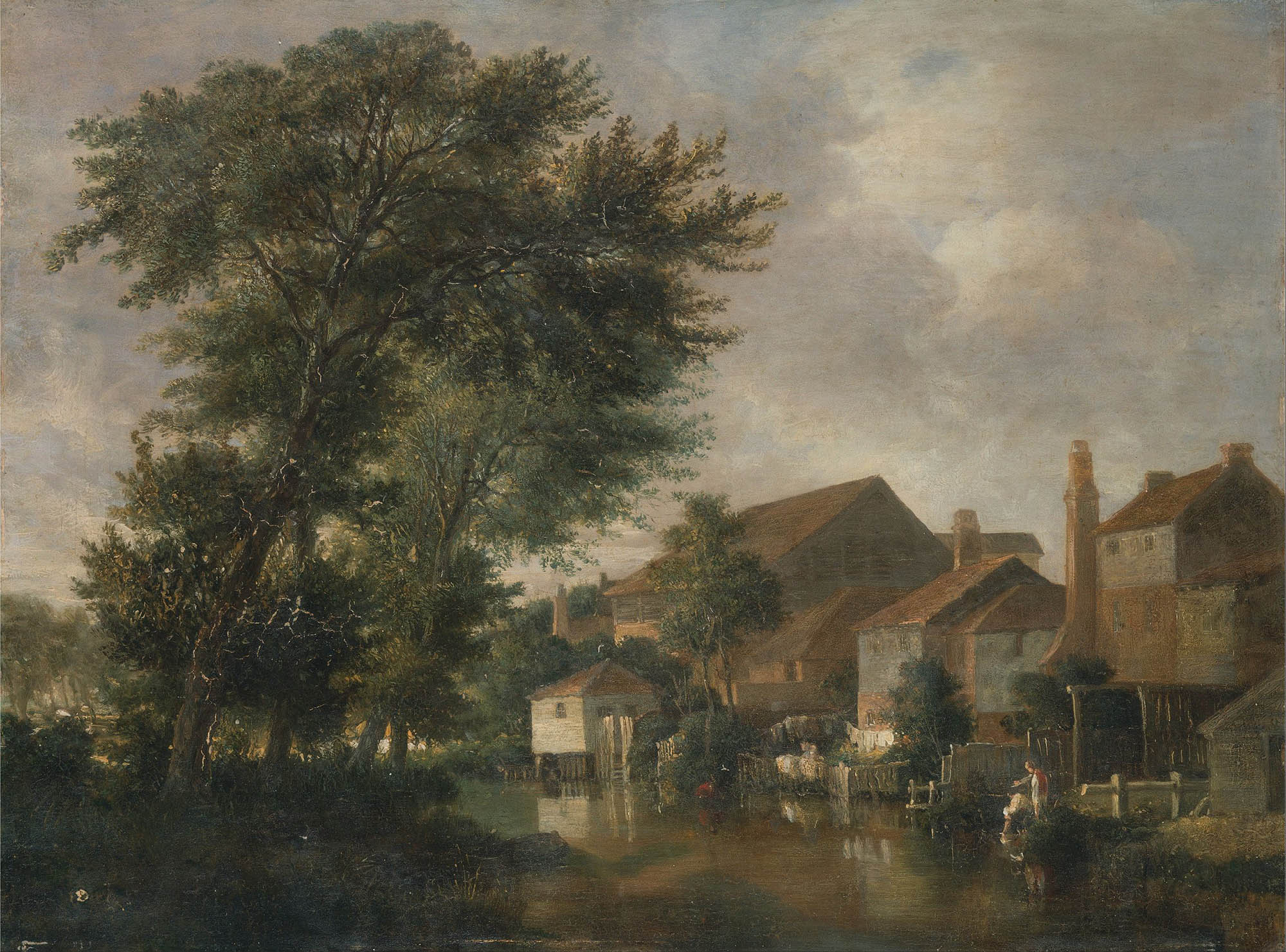
The River Wensum, Norwich by John Crome. c1814. The scene is looking up towards the St Crispin’s bridge and shows some of the dying works along the river.
The areas on both sides of the river were haunts for various members of the Norwich School of Painters, who often recorded the area around st Martin’s Gate and Fullers Hole. John Crome was especially fond of the area, he lived nearby on Green Street – now lost under St Crispins. He painted here fairly frequently on what was then known as the bleaching ground; where dyers and weavers lay their cloth out to bleach in the sun. Work included Norwich River: Afternoon, St Martin’s Gate, Back of New Mills, and The River Wensum in this area.
![Oak St 167 tower behind Dun Cow PH [6233] 1982-07-05](https://trainwood.co.uk/wp-content/uploads/2013/05/Oak-St-167-tower-behind-Dun-Cow-PH-6233-1982-07-05.jpg)
Oak St 167 City Wall tower behind the old Dun Cow pub 1982
(Courtesy George Plunkett)
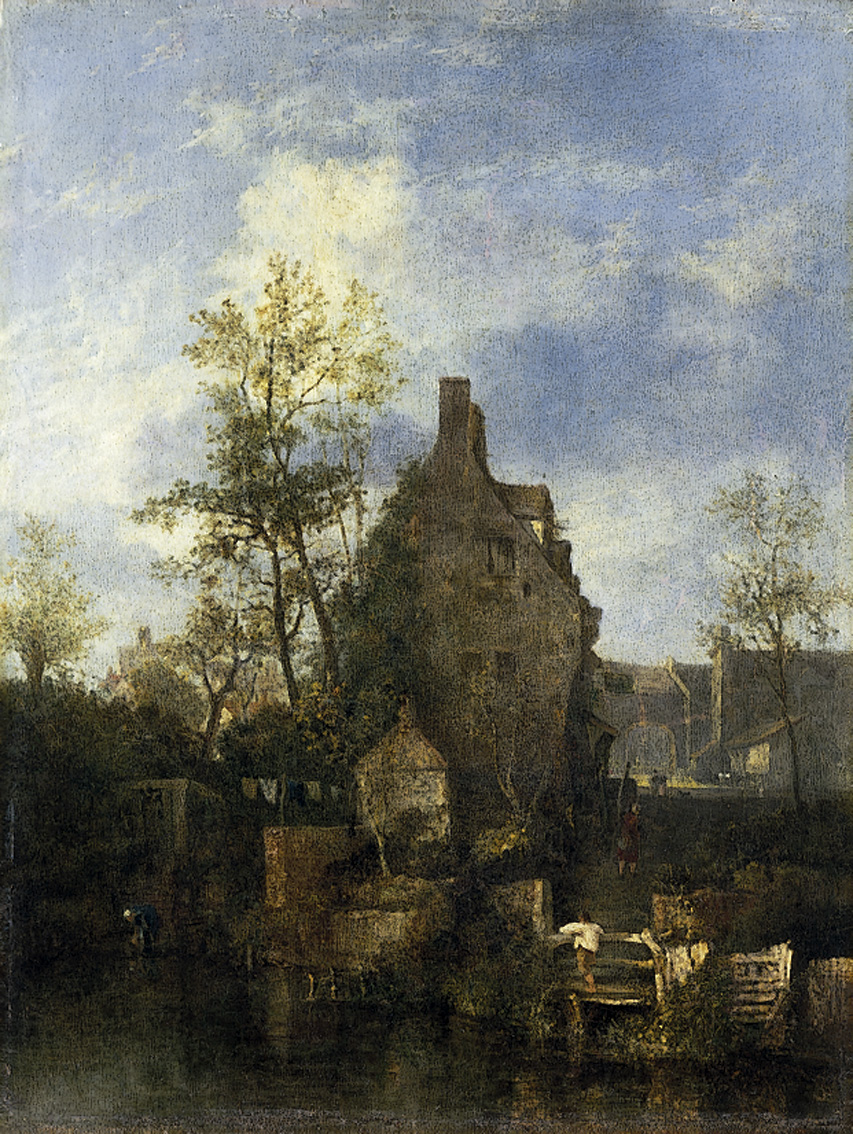
‘St Martin’s Gate, Norwich’ by John Crome (1768-1821), oil on panel, dated about 1812 to 1813. This scene was painted from Train wood, opposite the foot of what is now Tanners Court. The archway shown is the entrance to St Martin’s Close, formerly Fuller’s Hole.
The Station, railway and Baedeker Blitz heritage
Norwich City Station was built on the site in 1882 on a low swampy island between the River Wensum and a flood channel, which necessitated the building of two bridges made by Barnard, Bishop & Barnard of Norwich and an approach road onto the island. The main station building was Italianate in design with a central portico entrance, giving onto two main platforms covered with canopies bearing the letters E&MR (Eastern and Midlands Railway) in the spandrels. In the centre of the main platforms, 250ft from the main entry, were two short bay platforms used mainly for storage. Due to the swampy nature of the ground, the main entrance arch had already begun to crack and subside by 1900.
A tramway adjacent to platform one was laid across Station Road, following the west side of the Wensum, to the corporation depot at New Mills Yard. Coal trains were piloted from the station, over a level crossing, by a local shunter to the coal shute, a short wooden two-line jetty built out over the river, where a wooden crane unloaded the coal onto barges which were taken to the gas works near Bishops Bridge Road. All that remains of this operation, closed in the 1930s, are two short sets of tracks embedded in the cobbles which emerge from under the later built sewage pumping station at New Mills. To the east of the main line was a three road engine shed, two signal boxes (Norwich North & South), a drivers’ canteen, water tower, and a 60ft turntable which was installed in January 1931.
![Wensum M and GN rail bridge from Dolphin Br [B154] 1931-00-00](https://trainwood.co.uk/wp-content/uploads/2013/05/Wensum-M-and-GN-rail-bridge-from-Dolphin-Br-B154-1931-00-00.jpg)
Wensum M&GN rail bridge from Dolphin Bridge (courtesy George Plunkett)
The connection into the goods yard was singled in 1926 and the north signal box demolished in 1934, with its duties replaced by the Norwich south box and an auxiliary tablet hut ground frame. Norwich south signal box was demolished in October 1962. The goods yard occupied a vast area of land, encompassing the cattle sidings, often with over one hundred wagon movements a day, down as far as Heigham Street where cattle lairs and pens for loading the animals onto trains were situated.
When the corporation yard moved to the end of Barker Street in the 1930s, a new coal siding was installed via a goods spur. Traffic movement into the yard was a complicated affair involving coal trains from the north being shunted into the goods yard then back onto a spur siding and, points changed at a ground frame, shunted in the opposite direction into the corporation yard. This became the scene of tragic accident in November 1944 when a B-24 Liberator, on an instrument landing training flight from Horsham St Faiths, hit the tower of St Phillips Church, severing 12ft off its right wing and, crippled, flipped over on its back and crashed inside the yard. No civilians on the ground were hurt but the bomber crew were killed in the incident.
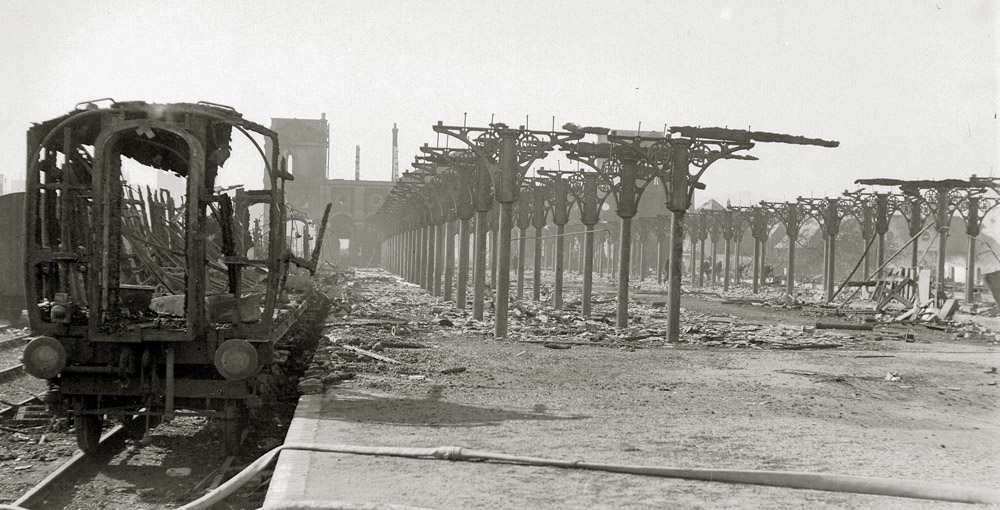
City Station after the aerial attack on 27th/28th April 1942. Photo courtesy EDP Archive
The main station buildings were badly damaged by an air raid on the night of the 27th/28th April 1942. The station appears to have been the main initial focus of the attacks on the city. Initially, high explosives were dropped on the station, followed by incendiaries. The platform canopies were totally burnt out and the already cracked portico was further damaged by the blast. The wood also contains the only known remaining bomb crater from WW2 in the city – a 250kg bomb believed to have been dropped by a Dornier.
The station buildings were largely demolished and new buildings were adapted from LNER (London and North Eastern Railway) sectional concrete huts which remained until the station closed.
With passenger numbers dwindling, in 1959 the line was closed to all but freight traffic until 1969, when City Station shut and was left to the encroaching undergrowth. Trees grew where trains once thundered on their way to bright holiday destinations or lowering herds of cattle were shipped off to pastures new. No more the shrill whistle of departure or the clank of coupling rods. The last A2 diesel railcar to Melton Constable had definitely left the station.
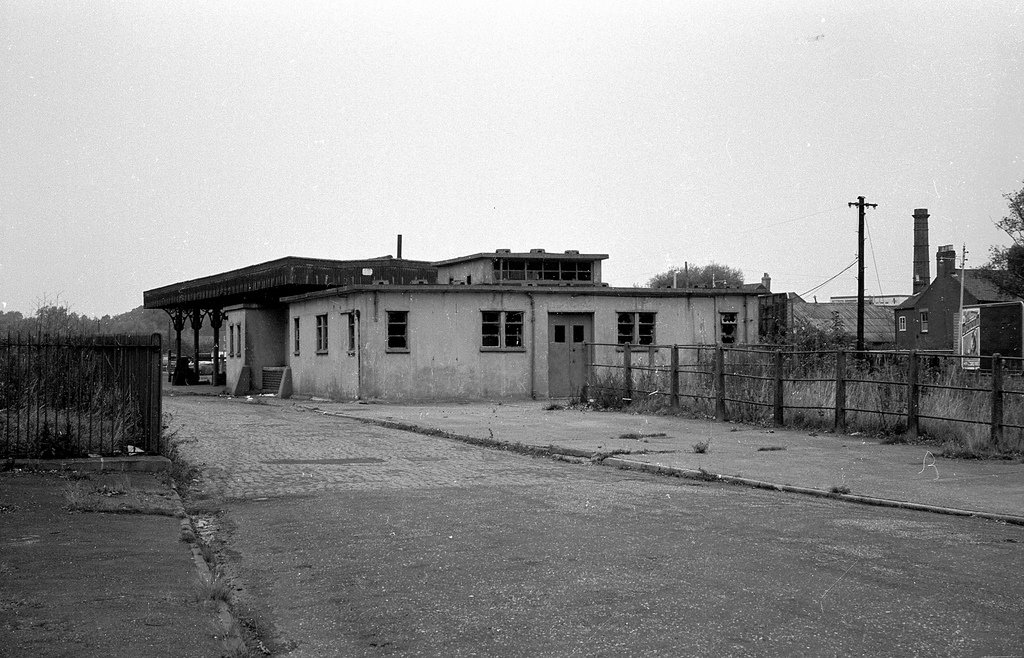
City Station From Barn Road after closure c1969.
Considering Norwich City Station was the main terminus on the M&GN line it is surprising so little of the structure remains. During the 1970s, when the inner ring road was under construction, the platform infill was robbed out and used to build the mound on St Crispin’s roundabout and as hardcore for the duelling of nearby roads. The houses on Barker Street were demolished and the road extended south east.
In 1976, local photographer Mark Dufton visited the site before the foliage took over completely and found the bay platforms. From 2011 Friends of Norwich City Station (FONCS) began digging at the site to preserve what is left of the station and surrounding buildings. Their work was focused on platform one, where a wall was found and the bay area cleared of undergrowth. Their hope was to uncover all the railway related parts to the area and turn it into a memorial garden as a tribute to the station and all who served the railway, including planting flowers and small bushes, notice signs and information boards of old pictures and M&GN benches. According to Jon Batley of FONCS, most of the station remains are there but were buried under tons of sludge when the river bottom was dredged. It is just a question of digging down to it.
The Marriott’s Way footpath, named for William Marriott – chief engineer and manager of the M&GN for 41 years – was extended to Norwich and follows the course of the old railway line.
The site has now returned to mixed wet and dry woodland, a habitat for many types of plant, insect and animal not found elsewhere in the city.
(Information regarding the station courtesy of FONCS)
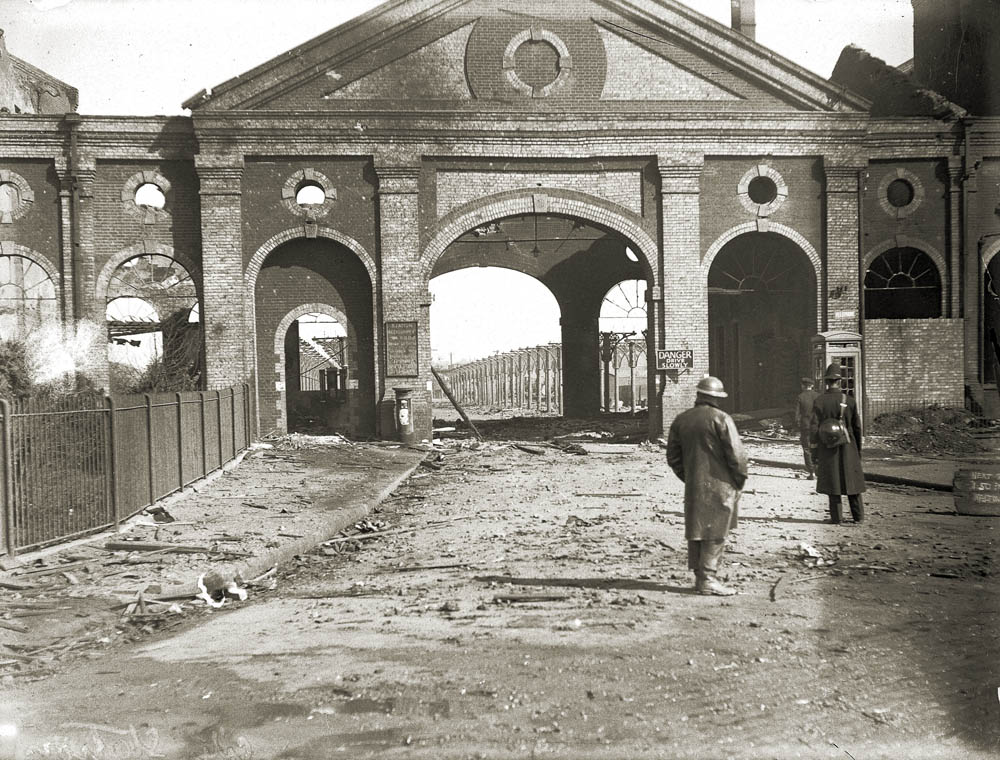
The Station Portico showing Blitz damage. Photo George Swain.
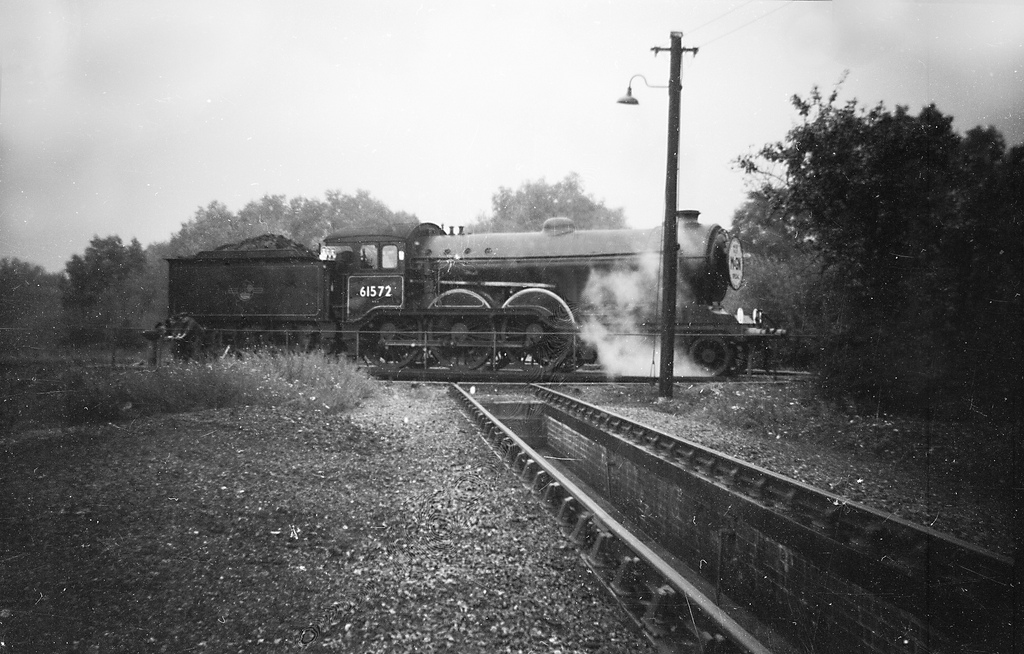
Norwich City Station’s 60 foot turntable and ashpit. Three men are turning it manually.
